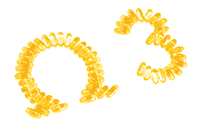Dietary fat has long been associated with weight gain and other health issues in humans. More recently, and probably as a result of the increasing pet obesity epidemic, it has become trendy to view dietary fat as a problem for companion animals as well.
The fact is fat is a vital part of a nutritionally balanced diet for your dog or cat. It is carbohydrate intake and lack of exercise, not dietary fat that accounts for the vast majority of overweight pets. Dietary fat contributes to the health and well-being of companion animals in many ways, including:
• Fat is a concentrated energy source for dogs and cats.
• Fat makes up part of the membrane of cells and also helps transport nutrients and other substances
across the cell membrane.
• Fats produce metabolites that help control inflammation.
• Fats contribute to the formation of some hormones, such as estrogen, testosterone and
progesterone.
• Fats contribute to the formation of bile acids, which aid in digestion and absorption of nutrients.
• Fat acts as a mechanical barrier, insulating the body against heat loss, protecting internal organs
and preventing excess water loss.
 The concept of ‘good fat’ vs ‘bad fat’ in the diet is much more relevant to human health than the health of our pets. Certain types of fat are associated with heart disease and stroke in people, the same does not hold true for companion animals. The concept of ‘good fat’ vs ‘bad fat’ in the diet is much more relevant to human health than the health of our pets. Certain types of fat are associated with heart disease and stroke in people, the same does not hold true for companion animals.
Your dog or cat’s body is designed to use and process dietary fat differently than yours does. Pets naturally have more good cholesterol (HDL) than bad (LDL). Your dog or cat won’t develop high blood cholesterol or thickening of the arteries from fat in his diet.
Since the good fat/bad fat notion isn’t accurate when it comes to your pet’s diet, the American Veterinary Medical Association (AVMA) and the American College of Veterinary Nutrition categorize dietary fats for companion animals as either facilitative or functional.
Facilitative fats are saturated fats. They are found in relatively large amounts in the diets of cats and dogs, and aren’t considered to be detrimental to a pet’s health except in the case of obese animals fed diets high in both fat and calories.
• Facilitative fats provide a number of benefits in your pet’s diet, including:
• Improving the taste and texture of food
• Converting to energy to fuel metabolic processes
• Providing high-calorie energy for physical movement, regulation of body temperature,
growth and reproduction
• Assisting in the digestion and absorption of fat- soluble vitamins
• Storage in adipose tissue for future use as energy if needed
Functional fats are usually, but not always, essential fatty acids. These fats are called ‘essential’ because they are a vital part of your pet’s diet, something your pet can’t produce on thier own.
Essential fatty acids are known by the commonly recognized terms omega-6 fats and omega-3 fats. Your pet needs a balance of both for good health. Not only does your pet need both types of fat in her diet, she needs them in the proper ratio. Current recommendations are for ratios of anywhere from 10:1 to 5:1 (omega-6 to omega-3). Here are the most common types of each omega.
 Omega-6 fats: Arachidonic acid (AA), Dihomo-gamma-linolenic acid (DGLA), Gamma linolenic acid (GLA), Linolenic acid (LA) Omega-6 fats: Arachidonic acid (AA), Dihomo-gamma-linolenic acid (DGLA), Gamma linolenic acid (GLA), Linolenic acid (LA)
Omega-3 fats: Alpha-linolenic acid (ALA), Docosahexaenoic acid (DHA), Eicosapentaneoic (EPA)
Essential fatty acids, in particular omega-3s, play a huge role in your pet’s health in many ways, among them:
• Improving the health of your pet’s skin and coat. Poor skin condition puts your dog or cat at risk for
itching, irritation,skin allergies and bacterial
infections.
• Alleviating the harmful effects of allergies and other conditions that result from an over reactive
immune system response.
• Reducing the inflammation associated with arthritis (including rheumatoid arthritis) and other
diseases -- such as ulcerative colitis and IBD, both
produce inflammation.
• Slowing the growth of common yeast infections in dogs and cats.
• Aiding proper development of the retina and visual cortex.
• Preventing certain heart problems in your pet.
• Maintaining healthy blood pressure and decreasing triglyceride and blood cholesterol
levels.
• Regulating blood-clotting activity.
• Slowing the development and spread of certain pet cancers.
Both omega-6 and omega-3 fats are very vulnerable to damage from heat. So even if these fats were once present in your pet’s food, it’s possible they lost their bio-availability during the kibbling or canning process. It’s one of many reasons why a homemade, species-appropriate diet is ideal for your cat or dog.
Omega-3s are also very sensitive to oxygen and can become damaged quickly.
As a general rule, omega-6 deficiencies are rare in companion animals because commercial pet food diets typically provide too much rather than too little of these fats.
If you should have a need to supplement omega-6 fats in your pet’s diet, plant oils like flaxseed, hemp and pumpkin seeds are good sources. Krill or Polluck oil is the supplement I recommend to insure your dog or cat is getting enough omega-3 fats in his diet.
As always, it’s important to seek the advice of your holistic veterinarian to determine how to best supplement your dog’s or cat’s diet with the fatty acids she needs for good health and to treat any specific health conditions she may have.
|